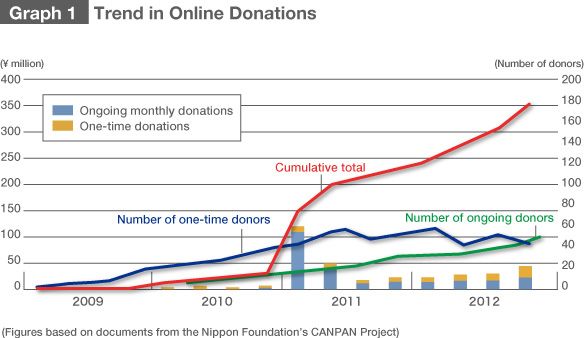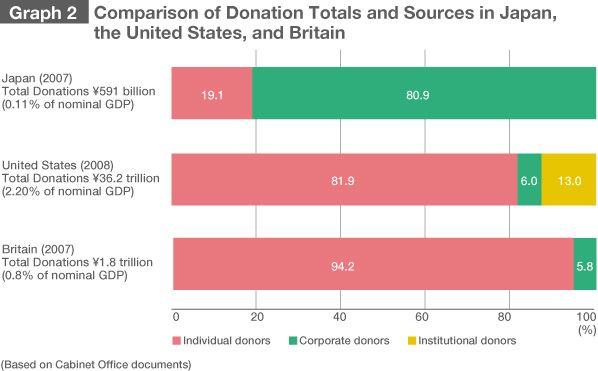
Japan’s New Donation Culture
Society- English
- 日本語
- 简体字
- 繁體字
- Français
- Español
- العربية
- Русский
Tōhoku Earthquake Brings Donating Closer to Home
According to the calculations of the Japan Fundraising Association, a total of around ¥600 billion in donations were collected after the Great East Japan Earthquake that struck on March 11, 2011—roughly the same amount of donations normally made during an entire year in Japan. Moreover, across Japan more than 85 million people, or 76.9% of the population over 15 years of age (as of 2011), made monetary or material donations in response to the disaster. A survey of some of these donors revealed that around 80% agreed more or less with the statement that “charitable donations are a way to contribute to society.”

The same trends can be seen in the calculations (Graph 1) of the Nippon Foundation’s CANPAN Project. In addition to supporting the activities of NPOs through financial assistance and information sharing, the project provides a settlement service for online donations. The amount of donations processed through the settlement service for the period from January to March 2011, when the earthquake occurred, was upwards of ¥118 million, roughly 17 times the amount received in the previous quarter. And it has continued to rise ever since. The growth in the number of NPOs that use online settlement services is also noteworthy. This seems to be the result of making online donating easier, which has encouraging the public to participate in philanthropic activities.
Although the March 2011 left deep scars on Japan, it has also sparked major changes and marked a turning point in terms of facilitating Japan’s donation culture.
Small Scale Compared to the United States
What has been situation of charitable donations in Japan until now? The scale is small in comparison to the United States.

According to calculations by Japan’s Cabinet Office (Graph 2), total donations in Japan in 2007 amounted to ¥591 billion, representing 0.11% of the nominal GDP that year. That amount was ¥600 billion less than the single donation total following the March 11 earthquake. Britain and the United States are miles ahead of Japan in terms of donations, recording figures of ¥1.8 trillion (0.80% of nominal GDP) and ¥36.2 trillion (2.20%), respectively. Another noticeable difference is that the percentage of individual donors in Japan is quite small.
This does not mean, however, that donations are any less needed in Japan than they are in Europe or the United States. The figures from the Cabinet Office show that donations accounted for more than 50% of the financial resources of government-certified NPOs. Moreover, the demand for monetary donations in the nonprofit sector is expected to rise steadily in the future. As of March 25, 2013, the list of certified NPOs stood at 389, a marked increase from 2012. If the number of organizations continues to increase at the rate up to now, more and more groups will be competing for a small pool of donations.
Cultivating a Donation Culture
One reason why a donation culture did not take root in Japan in the past has to do with an imbalance in the tax system regarding philanthropic activities. In Japan, unlike Europe and the United States, no special tax benefits were extended to donors. However, Japan’s tax system for donations has changed in recent years, as Hashimoto Tomoyuki, former director of the CANPAN Project, explains: “Thanks to legal revisions it is now much easier to give or receive donations. In fact, Japan now leads the world in terms of making it easy to receive donations. The problem comes down the scarcity of major donors. It is important to cultivate a donation culture in Japan, and we hope to provide assistance to connect NPOs with major donors.”
(Originally written in Japanese by Masuda Miki; banner image courtesy of Kitagawa Toshihiro/Aflo.)
Great East Japan Earthquake Donation the Nippon Foundation CANPAN Project